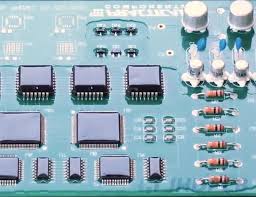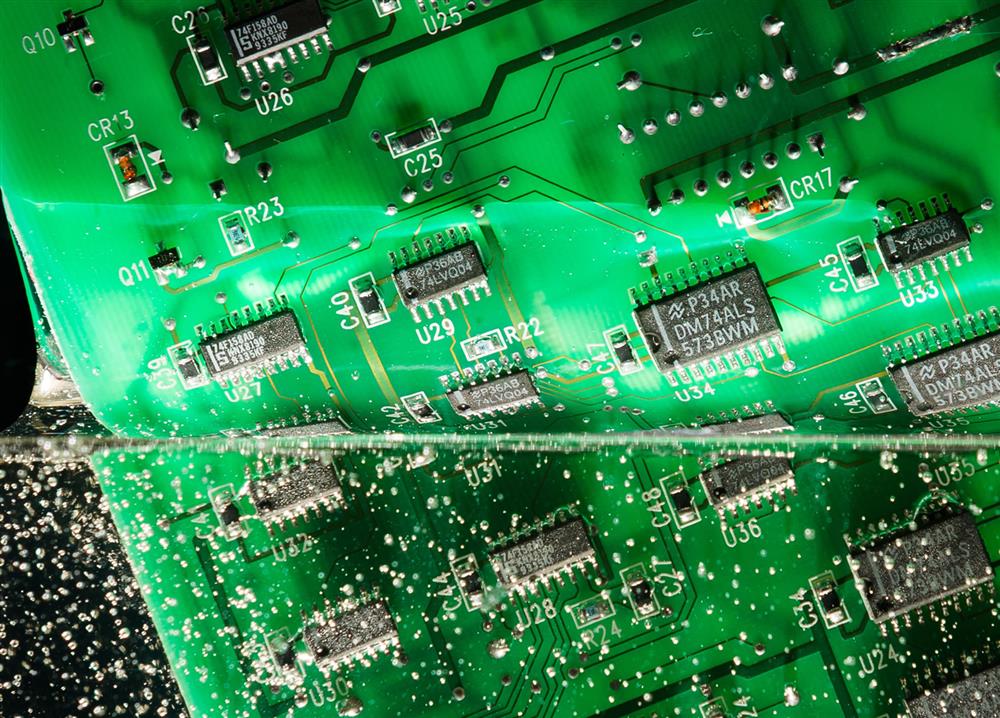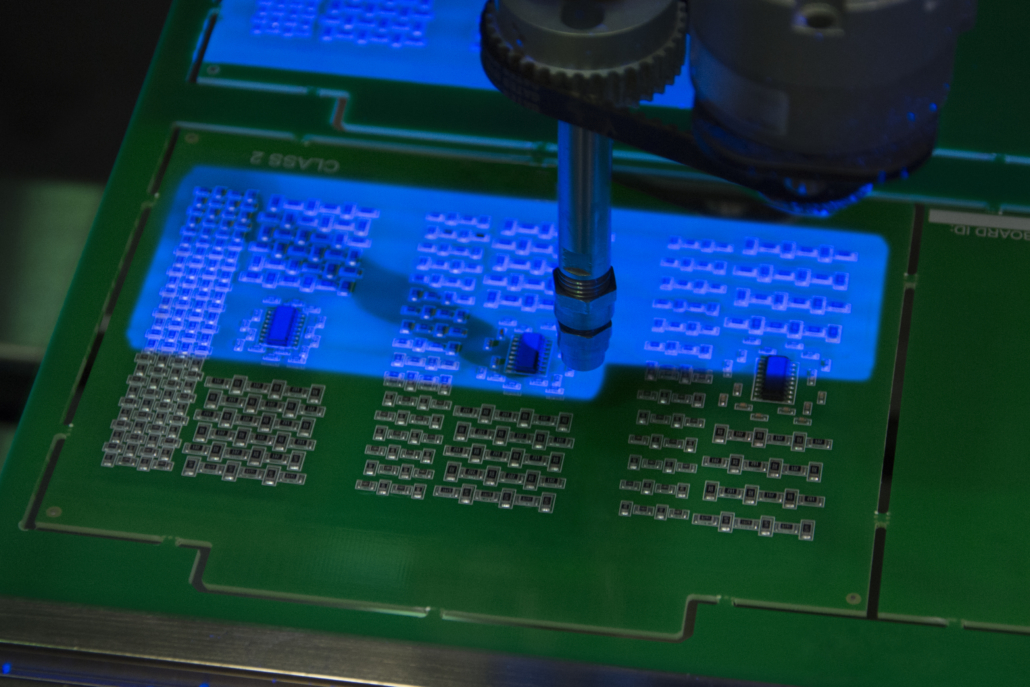Printed Circuit Boards (PCBs) are the backbone of modern electronics, powering everything from smartphones to aerospace systems. However, their intricate designs and delicate components are vulnerable to environmental hazards like moisture, dust, chemicals, and temperature extremes. Without proper protection, these factors can lead to corrosion, short circuits, or complete failure, compromising device reliability. This is where conformal coating comes in—a thin, protective layer that shields PCBs from harm while maintaining their performance.
In this blog, we dive deep into the world of conformal coatings, exploring their purpose, types, application methods, and best practices. Whether you're an engineer designing consumer electronics or mission-critical systems, understanding conformal coating is key to ensuring long-term durability and reliability. Let's get started.
What is Conformal Coating?
Conformal coating is a thin polymeric film, typically 25–250 µm thick, applied to a PCB to protect it from environmental damage. The coating 'conforms' to the board's contours, covering solder joints, component leads, exposed traces, and other vulnerable areas. It acts as a barrier against moisture, dust, chemicals, and temperature fluctuations, while also enhancing dielectric strength to prevent electrical arcing or leakage.
Unlike potting, which encases the entire PCB in a thick resin, conformal coating is lightweight and breathable, allowing moisture to escape while blocking contaminants. This makes it ideal for applications where weight, size, and repairability are critical, such as handheld devices or automotive electronics. For example, a smartphone PCB coated with a 50 µm silicone layer can withstand humidity levels up to 90% RH without corrosion, extending its operational life.

Why Conformal Coating is Essential for PCBs
PCBs operate in diverse environments, from humid marine settings to dusty industrial floors. Without protection, they face several risks:
- Moisture and Humidity: Water can cause short circuits or corrode metal components, reducing surface insulation resistance (SIR) below acceptable levels (e.g., from 1010 ohms to 108 ohms).
- Chemicals and Corrosive Gases: Exposure to acids, solvents, or salt spray (common in marine applications) can erode traces and solder joints.
- Dust and Debris: Particulate buildup can disrupt connections or cause overheating, especially in high-power circuits.
- Temperature Extremes: Rapid thermal cycling (e.g., -65°C to 100°C in aerospace applications) can stress components, leading to cracks or delamination.
- Mechanical Stress: Vibrations in automotive or industrial systems can loosen connections or damage delicate components.
Conformal coating mitigates these risks by providing insulation, corrosion resistance, and mechanical stability. For instance, a polyurethane-coated PCB in an automotive ECU can maintain functionality despite exposure to gasoline vapors or salt mist, ensuring compliance with standards like IPC-CC-830.
Recommenned Reading: Conformal Coating and PCBA Reliability: Enhancing Protection and Performance
Types of Conformal Coatings
Choosing the right conformal coating depends on the PCB's operating environment, application method, and repair needs. Below are the most common types, along with their properties and use cases.
Acrylic Coatings
Acrylic coatings are cost-effective and easy to apply, drying quickly via solvent evaporation. They offer good moisture resistance and dielectric strength (e.g., 1100 volts minimum for a 30 µm layer) but have limited chemical resistance. Their ease of removal with solvents makes them ideal for applications requiring frequent rework, such as consumer electronics.
- Pros: Affordable, easy to apply, rework-friendly.
- Cons: Limited solvent and high-temperature resistance (up to 130°C).
- Use Cases: Home appliances, office electronics.
Silicone Coatings
Silicone coatings excel in high-humidity and wide-temperature environments, retaining flexibility from -65°C to 200°C. They provide excellent moisture and corrosion resistance but are harder to remove, requiring specialized solvents. Their rubbery texture absorbs vibrations, making them suitable for marine and aerospace applications.
- Pros: Broad temperature range, vibration resistance, moisture protection.
- Cons: Difficult to remove, moderate abrasion resistance.
- Use Cases: Marine electronics, aerospace systems, RC circuits.
Polyurethane (Urethane) Coatings
Polyurethane coatings are tough, offering superior chemical and abrasion resistance. They protect against harsh environments, such as exposure to acids or brake fluid in automotive systems. However, their curing process is slower, often requiring UV or heat, and removal is challenging.
- Pros: Chemical resistance, durability, FDA-approved for medical devices.
- Cons: Slow curing, difficult to rework.
- Use Cases: Automotive ECUs, medical devices.
Suggested Reading: Conformal Coating for SMD PCBs: Protecting Your Electronics from Harsh Environments
Epoxy Coatings
Epoxy coatings provide robust protection against chemicals, moisture, and abrasion but are less flexible, making them prone to cracking under thermal cycling. They're best for stable, harsh environments like oil and gas applications, where a 100 µm layer can withstand 7-day water immersion without SIR degradation.
- Pros: High chemical and abrasion resistance, smooth finish.
- Cons: Brittle, limited flexibility, hard to remove.
- Use Cases: Industrial controls, oil and gas electronics.
Parylene Coatings
Parylene is applied via vapor phase deposition, creating an ultra-thin (0.1–76 µm), pinhole-free film with exceptional moisture and dielectric properties (e.g., IPX7/IPX8 waterproofing). Its uniform coverage is ideal for complex PCBs with sharp edges, but the process is expensive, and rework requires abrasion techniques.
- Pros: Superior moisture protection, thin and uniform, high dielectric strength.
- Cons: Costly, difficult to apply and remove.
- Use Cases: Medical implants, aerospace avionics.
Application Methods for Conformal Coatings
The application method impacts coating uniformity, production speed, and cost. Here's an overview of the most common techniques:
- Brush Coating: A manual method for low-volume production or touch-ups. It's operator-dependent, often resulting in uneven thickness (e.g., 50–100 µm), and is prone to defects like bubbles. Best for prototyping or repairs.
- Manual Spraying: Uses aerosol cans or handheld guns, suitable for small batches. It requires masking to protect uncoated areas, and consistency varies, with typical thicknesses of 30–70 µm.
- Automated Spraying: PCBs move on a conveyor under a programmed spray head, ensuring uniform coverage (25–50 µm) for medium to high volumes. It reduces operator error but still requires masking.
- Dipping: The PCB is immersed in a coating solution and withdrawn at a controlled speed. It's ideal for high-volume production, achieving 50–130 µm thickness, but extensive masking is needed to avoid coating connectors or sensitive components.
- Selective Coating: Robotic nozzles apply coating to specific areas, eliminating masking. It's fast and precise, with thicknesses of 30–100 µm, making it perfect for complex PCBs in automotive or aerospace applications.
- Vapor Deposition (Parylene): A vacuum-based process for parylene, depositing a uniform 10–50 µm layer. It's costly but ensures coverage on intricate designs.

Best Practices for Conformal Coating Application
To maximize protection, follow these best practices during the coating process:
- Surface Preparation: Clean the PCB using vapor degreasing or semi-aqueous washing to remove flux residues, oils, or fingerprints. Contaminants can cause pinholes, reducing SIR below 109 ohms.
- Masking: Protect areas like connectors, EMI shields, or batteries from coating. Use peelable masks or tapes to ensure clean edges and prevent coating creep.
- Environmental Control: Maintain a stable application environment (e.g., 20–25°C, 40–60% RH) to prevent defects like orange peel or mud cracking in water-based coatings.
- Thickness Control: Adhere to IPC standards (e.g., 30–130 µm for acrylic, 50–210 µm for silicone). Use wet or dry film measurement techniques to verify thickness non-destructively.
- Curing: Follow the coating's curing requirements—evaporative for acrylics, UV for polyurethanes, or moisture for silicones. Incomplete curing can reduce adhesion, leading to delamination under thermal shock.
- Inspection: Use automated optical inspection (AOI) or UV lamps to check for uniform coverage, pinholes, or missed areas. Fluorescent dyes in coatings aid visual inspection.
- Testing: Conduct environmental tests (e.g., 96 hours at 90% RH, 35°C, or 7-day water immersion) to ensure SIR remains above 108 ohms and no corrosion occurs.

Challenges and Considerations
While conformal coatings offer significant benefits, they come with challenges:
- Rework and Repair: Acrylics are easy to remove, but parylene and epoxy require specialized techniques, increasing costs. For example, removing a 50 µm parylene layer may need micro-abrasion, costing $50–100 per board.
- Coating Defects: Pinholes, bubbles, or uneven thickness can compromise protection. A 10 µm pinhole can reduce dielectric strength by 20%, risking arcing.
- Environmental Regulations: Solvent-based coatings face restrictions due to VOC emissions. Water-based or UV-cure options are greener but may have slower curing times (e.g., 24 hours for water-based vs. seconds for UV).
- Cost vs. Performance: Parylene offers superior protection but costs $10–50 per board, compared to $1–5 for acrylics. Budget constraints may limit its use to high-reliability applications.
Engineers must balance these factors based on the PCB's end-use, production volume, and budget.
How ALLPCB Supports Conformal Coating Needs
At ALLPCB, we understand the critical role conformal coating plays in PCB reliability. Our advanced manufacturing capabilities and quick-turn prototyping services ensure your PCBs are protected to meet stringent industry standards. Whether you need acrylic coatings for cost-effective consumer electronics or parylene for aerospace applications, our global logistics and state-of-the-art facilities deliver tailored solutions. With expertise in selective coating and automated spraying, we help engineers achieve uniform coverage and fast turnaround, even for complex designs, ensuring your PCBs withstand the harshest environments.
Future Trends in Conformal Coating
The electronics industry is evolving, and conformal coatings are adapting to meet new demands:
- Eco-Friendly Coatings: Water-based and UV-cure coatings are gaining traction to comply with regulations like CARB, reducing VOC emissions by up to 80%.
- Nano-Coatings: Fluorocarbon-based thin-film coatings (1–5 µm) offer hydrophobicity for wearables, protecting against brief water exposure (e.g., IPX4 splash resistance).
- Smart Coatings: Research into self-healing coatings could extend PCB lifespans by repairing micro-cracks during thermal cycling.
- Automation: Advances in robotic selective coating systems are reducing masking time by 50%, boosting throughput for high-volume production.
These innovations promise enhanced protection and sustainability, keeping PCBs reliable in increasingly demanding applications.
Conclusion
Conformal coating is a vital step in safeguarding PCBs from environmental damage, ensuring reliability and longevity in applications from consumer gadgets to aerospace systems. By understanding the types of coatings, application methods, and best practices, engineers can make informed decisions to protect their designs. Whether it's choosing silicone for high-humidity environments or parylene for medical implants, the right coating can make all the difference.
At ALLPCB, we're committed to helping you achieve durable, high-performance PCBs. By staying informed about coating technologies and partnering with a trusted manufacturer, you can confidently tackle the challenges of modern electronics design. Protect your PCBs today, and build devices that stand the test of time.
 ALLPCB
ALLPCB







